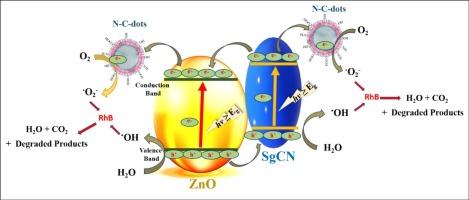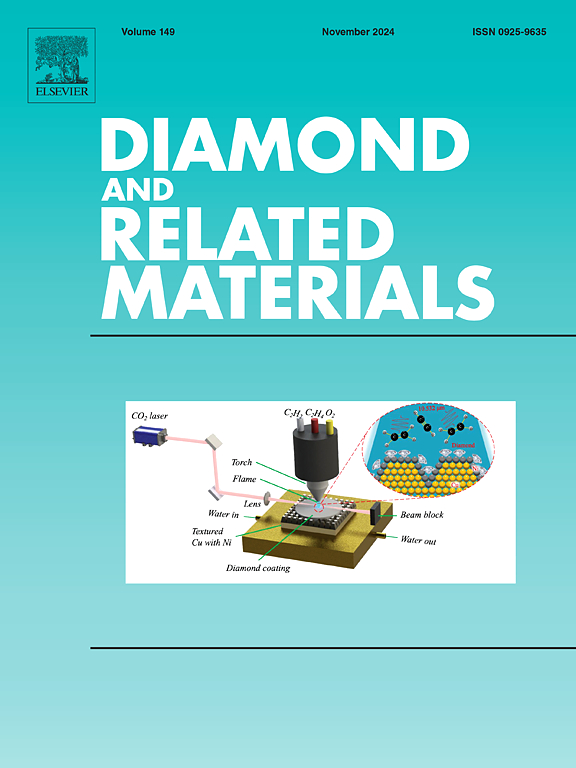绿色合成 N-C 点装饰对 S-g-C3N4/ZnO 光催化效率影响的研究
IF 4.3
3区 材料科学
Q2 MATERIALS SCIENCE, COATINGS & FILMS
引用次数: 0
摘要
在这里,绿色合成的掺杂氮的碳点(N-C-dots)和原位生产的掺硫氮化石墨碳(S-g-C3N4)和氧化锌的二元复合材料经过水热处理,形成了它们的三元复合材料,即:N-C-dots/S-g-C3N4/氧化锌(N-C-dots/SgCN/ZnO)、N-C-dots/S-g-C3N4/ZnO (N-C-dots/SgCN/ZnO),以研究在 SgCN/ZnO 上装饰 N-C-dots 对光催化分解罗丹明 B (RhB) 染料的影响。所获得的 N-C 点几乎呈球形,具有显著的结晶特性,颗粒直径在 6.21 至 12.56 nm 之间。所获得的 N-C 点/SgCN/ZnO 三元复合材料的光催化效率明显高于其组成成分。此外,在优化条件下,N-C-点/SgCN/ZnO 在 35 分钟内就能出色地光催化分解 RhB 染料(93.49%)。对光催化剂剂量、染料浓度、染料溶液 pH 值等各种染料降解参数以及不同清除剂的影响进行了优化。捕获实验结果表明,h+、-O2- 和 -OH 自由基是光催化分解染料的主要成分,其中 O2- - 是主要的降解成分,而 -OH 和 h+ 则是次要成分。N-C-dots/SgCN/ZnO 在 5 个循环中表现出卓越的重复使用性,在第 5 个循环中,仅用 35 分钟就降解了 85.54 % 的 RhB 染料。此外,在新制样品和回收样品的 XRD 图谱中仅观察到微小的变化,这表明三元复合材料具有卓越的稳定性。本文章由计算机程序翻译,如有差异,请以英文原文为准。

Investigation on the impact of green synthesized N-C-dots decoration over photocatalytic efficiency of S-g-C3N4/ZnO
Herein, green synthesized N-doped carbon dots (N-C-dots) and in-situ produced binary composites of sulphur-doped graphitic carbon nitride (S-g-C3N4) and ZnO have been hydrothermally treated to develop their ternary composite, i.e., N-C-dots/S-g-C3N4/ZnO (N-C-dots/SgCN/ZnO) to investigate the impact of N-C-dots decoration over SgCN/ZnO for photocatalytic decomposition of rhodamine B (RhB) dye. The obtained N-C-dots are almost spherical and exhibited remarkable crystalline properties, with particles diameters ranging from 6.21 to 12.56 nm. The obtained ternary composite N-C-dots/SgCN/ZnO showed noticeably higher photocatalytic effectiveness than its constituents' components. Additionally, N-C-dots/SgCN/ZnO demonstrated outstanding photocatalytic decomposition (93.49 %) of RhB dye under optimized conditions in only 35 min. Various dye degradation parameters like photocatalyst dose, dye concentration, pH of dye solution have been optimized for RhB degradation along with impacts of different scavengers. The results of capturing experiments revealed that h+, •O2− and •OH radicals are main components for photocatalytic breakdown of dye with O2• − rendering the major degradation, whereas •OH and h+ have minor involvement. N-C-dots/SgCN/ZnO demonstrated outstanding reusability up to five cycles by degrading 85.54 % RhB dye in 5th cycle in just 35 min. Additionally, only slight variations are observed in XRD pattern of freshly produced and recycled sample, indicating exceptional ternary composite stability.
求助全文
通过发布文献求助,成功后即可免费获取论文全文。
去求助
来源期刊

Diamond and Related Materials
工程技术-材料科学:综合
CiteScore
6.00
自引率
14.60%
发文量
702
审稿时长
2.1 months
期刊介绍:
DRM is a leading international journal that publishes new fundamental and applied research on all forms of diamond, the integration of diamond with other advanced materials and development of technologies exploiting diamond. The synthesis, characterization and processing of single crystal diamond, polycrystalline films, nanodiamond powders and heterostructures with other advanced materials are encouraged topics for technical and review articles. In addition to diamond, the journal publishes manuscripts on the synthesis, characterization and application of other related materials including diamond-like carbons, carbon nanotubes, graphene, and boron and carbon nitrides. Articles are sought on the chemical functionalization of diamond and related materials as well as their use in electrochemistry, energy storage and conversion, chemical and biological sensing, imaging, thermal management, photonic and quantum applications, electron emission and electronic devices.
The International Conference on Diamond and Carbon Materials has evolved into the largest and most well attended forum in the field of diamond, providing a forum to showcase the latest results in the science and technology of diamond and other carbon materials such as carbon nanotubes, graphene, and diamond-like carbon. Run annually in association with Diamond and Related Materials the conference provides junior and established researchers the opportunity to exchange the latest results ranging from fundamental physical and chemical concepts to applied research focusing on the next generation carbon-based devices.
 求助内容:
求助内容: 应助结果提醒方式:
应助结果提醒方式:


